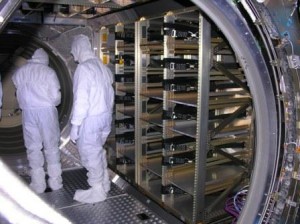ATV-3 Launch minus 4 months. Day 72 of the campaign – Tuesday, 8 November
The latest update from ESA’s Charlotte Beskow in Kourou – Ed.
For the past few weeks we have been doing basically two things: Solar Array Integration on the Space Craft (S/C) and Leak Checks on the Integrated Cargo Carrier (ICC). These are two activities which take quite some time.
In parallel we have been preparing for the arrival of the cargo. Cargo is, after all, the main purpose of ATV. ATV Cargo comes in several forms. Water for the astronoauts, air to breathe, fuel to keep ISS in orbit and dry cargo. The last item encompasses various items needed for ISS to function as a laboratory as well as tems the crew needs for their daily lives.
ATV can carry:
- up to 4,000 kg of propellant (for its own engines)
- up to 860 kg of Russian propellant for the ISS engines
- up to 860 kg of water (Russian or American and yes, they are different)
- up to 102 kg of gas (air, oxygen and/ or nitrogen)
- up to 5,500 kg of dry cargo.
These are max loads. For each ATV the actual cargo mix is defined according to the ISS needs at that time. For ATV-3 this means that Edoardo Amaldi will carry
- 2.900 kg of prop for our engines
- 860 kg of Russian propellant 285 kg of Russian water
- 102 kg of gas
- 2,450 kg of dry cargo
In other words, a total of 6,960 kg of cargo for the ISS.
The pressurised part of ATV is equipped with racks, you can think of this as space qualified shelves. Dry cargo is stored on these shelves and secured by belts. Monday and Tuesday this week the first two batches of dry cargo arrived.The state of each crates is inspected, and once opened, the state of the contents is checked as well.
Inside the crates are the carefully wrapped special cargo bags. Each bag carries labels which allow the handlers to identify which bag it is and what it contains. There are also labels on the side which describe the contents in order to make it simpler for Crew to find what they are looking for.

The bags are stored in a dedicated room until it is time to load the cargo into ATV. Credits: ESA/C. Beskow
The cargo team have carefully calculated where to optimally store the bag inside ATV. This is required to calculate the center of mass. It is of course also very important for the crew to know where each item is located. It’s a bit like being on a ship. There is not much free space so each item has a specific place.
So, what do the bags contain? Food clothing, paper, spare parts etc. These items will certainly be welcome on the ISS. So far 9 pallets have arrived. Another 10 are arriving today which will keep us busy most of the evening…more arrive next week and cargo loading starts end of November.
– Charlotte
Editor’s note: Access the full image gallery via Flickr





 Automated Transfer Vehicle page
Automated Transfer Vehicle page ATV blog archive
ATV blog archive
Discussion: no comments